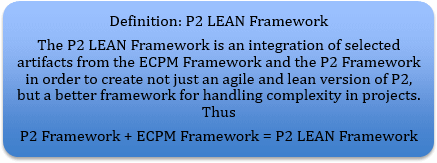What
We LikedChapter 1 introduces the concept of a P2 LEAN Framework
for planning and managing complex IT and HT projects that the authors define as
follows:[4] 
If
you have difficulty in understanding that, you will find the Glossary[5]
at the back of the book most helpful. Indeed, we particularly liked the availability
of such an extensive Glossary of terms, many of which are very specific to the
type of work described in the book. This book is well written and in a clear
style.[6] It is also well illustrated by
charts, diagrams and boxes presenting specific highlights. Given the comments
presented earlier, we would describe the book's content as not necessarily easy
reading but rather academic and relatively heavy reading for all but those already
immersed in large complex IT and HT projects. Nevertheless, it is highly interesting
for its re-purposing of tools and techniques that are known to be reliable and
realistic in the project domains of other industry and product sectors. We
particularly liked the systematic way in which the book's content is laid out.
As previously listed, there are four Parts that cover: (1) An Overview of
the Integrated Adaptive Agile and PRINCE2 LEAN Framework that the authors have
devised; (2) An "Ideation" phase; (3) A set-up phase; (4) An execution
Phase; followed by (5) A wrap up summary: "Putting it all together". The
chapters are similarly well constructed in that all begin with some relevant classic
quotations to brighten the chapter going forward, and then clearly describe the
chapter's learning objectives. Finally, after presenting learned content, each
chapter concludes with a "Putting it all together" paragraph as a chapter wrap-up.
It is also worth noting that for a project to be managed under the described system,
there is significant work to be done in the early Phases and their respective
Stages before you get to the Execution Phase. We mention this because there are
many PM practitioners who think or feel, wrongly, that a project does not really
begin until actual product is begun being produced in the active stages of the
Execution Phase. Some examples of the above-mentioned introductory quotations
follow: "It is a mistake to look too far ahead. Only one link
of the chain of destiny can be handled at a time." Winston Churchill, English
Prime Minister.[7]
"Objectives
are not fate; they are direction. They are not commands; they are commitment.
They do not determine the future; they are the means to mobilize the resources
and energies for making the future." Peter F. Drucker, Management consultant and
writer.[8]
"To
tend, unfailingly, unflinchingly, towards a goal, is the secret of success." Anna
Pavlova, Russian ballerina.[9]
Some
of the benefits claimed for using P2 LEAN are described in the book as follows:[10]
- "P2 LEAN uses established and proven best practices and governance
for project management."
- "P2[11]
is flexible, but using its flexibility takes a lot of experience. The chapter
on tailoring the method just doesn't get you there on its own. P2 LEAN actually
explains how to tailor the method."
- "P2 LEAN has adjusted
the P2 project responsibilities, but we believe it has made the organization structure
more effective, certainly for complex projects."
- "P2 has a good management
by exception philosophy, but P2 LEAN with its agile concept of rigid
time and cost parameters for a stage, removes a huge percentage of the exception
situations. Problems and unfinished work are put in the Scope Bank for evaluation
when planning the Next Stage."
If the project management approach
can achieve those ideals in the types of project described, then a close study
of this book is well worth the time and effort spent.
4.
Ibid, p5
5. See Appendix A. This Glossary contains a significant
number of definitions and Acronyms that are specific to the type of product development
described in the book.
6. This is assuming the reader recognizes
the time and effort required to absorb the new ideas and approach that are presented
here by the authors.
7. Ibid, p61
8.
Ibid, p121
9. Ibid, p201
10. Ibid,
p245
11. Ibid, P2 — That is to say PRINCE2, the original
European project management methodology — competitor to PMI's PMBOK Guide.
|



